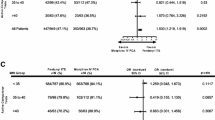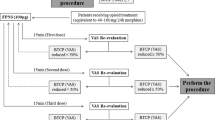Abstract
Objective
Interventional embolization therapy is well accepted in cancer treatment, but patient may suffer from a moderate-to-severe pain after therapy and its quality of life (QoL) is influenced, this study is to observe the efficacy and safety of transdermal fentanyl (TDF) in the management of pain caused by interventional embolization therapy.
Methods
Morphine 10mg and TDF 25μg/h were immediately used in 52 patients who had moderate-to-severe pain complicated by interventional embolization therapy, the pain intensity was evaluated by visual analogue scale (VAS). If VAS≥4 at 12 h after treatment, the dosage of TDF added into 50 μg/h. At Oh, 12h, 24h, 72h, 1 week, 2 weeks after TD, the vas and adverse events were observed respectively.
Result
There was an obvious decrease in VAS at 12h after TDF treatment in the patients of which only 9 patients used 50ug/h dosage after partial splenic embolization (PSE) therapy. Most patients got satisfactory pain relief both the TDF 25 μg/h and TDF 50 μg/h group (VAS 0-1). The adverse events were nausea, vomiting and dizzy, especially in the TDF 50 μg/h group. No respiratory depression was observed and only one patient got retention of urine.
Conclusion
TDF was effective and safe in the treatment of moderate-to-severe pain after interventional embolization therapy.
Similar content being viewed by others
Reference
World Health Organization. Cancer pain relief and palliative care: Report of a WHO Expert Committee[M]. 2ed. Geneva: World health Organization technical Report Series; 1996.
Radbruch L, Sabatowski R, Loick G, et al. Constipation and the use of laxatives; a comparison between transdermal fentanyl and oral morphine[J]. Palliate Med 2000; 14:111–119.
Ahmedzai S, Brooks D. Transdermal fentanyl versus sustained-release oral morphine in cancer pain: preference, efficacy, and quality of life[J]. J Pain Symptom Manage 1997; 13: 254–261.
Donner B, Zenz M, Tryba M, et al. Direct conversion from oral morphine to teansdermal fentanyl: a multicerter study in patients with cancer pain[J]. Pain 1996; 64: 527–534.
Zech DF, Grond SU, Lynch J, et al. Transdermal fentanyl and initial dose-finding with patient-controlled analgesia in cancer pain A pilot study with 20 terminally ill cancer patients[J]. Pain 1992; 50: 293–301.
Yeo W, Lam KK, Chan AT, et al. Transdermal fentanyl for severe cancer-related pain[J]. Palliat Med 1997; 11: 233–239.
Grond SU, Zech DF, Lehmann KA, et al. Transdermal fentanyl in the long-term treatment of cancer pain: a prospective study of 50 patients with advanced cancer of the gastrointestinal tract or the head and neck region[J]. Pain 1997; 69: 191–198.
Menten J, Desmedt M, Lossignol D, et al. Longitudinal follow-up of TTS-fentanyl use in patients with cancer-related pain; results of a compassionate-use study with special focus on elderly patients[J]. Curr Med Res Opin 2003; 18: 488–498.
Bjorneboe O, Pavelka K. Effects of Transdermal fentanyl on pain and functioning in rheumatoid arthritis[D]. In: Pain in Europe IV-4th Congress of the European Federation of IASP Chapters (EFIC), Prague, Czech Republic, 2003; p 249.
Herrero-Beaumont G, Le Loet X. Effects of transdermal fentanyl on pain and functioning in osteoarthritis[D]. In: Pain in Europe IV-4th congress of the European Federation of IASP Chapters (EFIC), Prague, Czech Republic, 2003; p.250.
Calis KA, Kohler DR, Corso DM. Transdermally administered fentanyl for pain management[J]. Clin Pharmacol 1992; 11: 22–36.
Jeal W, Benfield P. Transdermal fentanyl: a review of its pharmacological properties and therapeutic efficacy in pain control[J]. Drugs 1997; 53:109–138.
Grand S, Radbruch L, Lehmann KA. Clinical pharmacokinetics of transdermal opioids: focus on transdermal fentanyl[J]. Clin Pharmacokinet 2000; 38: 59–89.
Miguel R, Kreitzer JM. Postoperative pain control with a new transdermal delivery system[J]. Anesthesiology 1995; 83: 470–477.
Allan L, Hays H, Jensen NH, et al. Randomised crossover trial of transdermal fentanyl and sustained release morphine for treating chronic non-cancer pain[J]. BMJ 2001; 322:1–7
Mystakidou K, Parpa E, Tsilika E, et al. Pain management of cancer patients with transdermal fentanyl: a study of 1828 step I, II, & III transfers[J]. J Pain 2004; 5:119–132.
Radbruch L, Sabatowski R, Petzke F, et al. Transdermal fentanyl for the management of cancer pain: a survey of 1005 patients[J]. Palliat Med Res Opin 2001; 15: 309–321.
Fang WX, Wu XM. Observation on transdermal fentanyl for treatment of terminal carcinomatous pain[J]. Chin J Anesthesiol(in Chin) 2000; 1120:11, 695.
Author information
Authors and Affiliations
Corresponding author
Rights and permissions
About this article
Cite this article
Zhu, X., Yang, Rj. & Chen, H. Efficacy and safety of transdermal fentanyl (TDF) in treatment of pain caused by interventional embolization therapy. Chin. J. Cancer Res. 20, 316–319 (2008). https://doi.org/10.1007/s11670-008-0316-5
Received:
Accepted:
Published:
Issue Date:
DOI: https://doi.org/10.1007/s11670-008-0316-5




